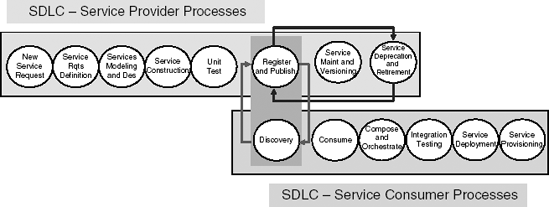8.4. SERVICE REUSABILITY
As has been mentioned in previous chapters, one of the key value propositions of SOA is service reusability, both to enable business flexibility and agility and also to reduce IT redundancy and minimize operational costs to the enterprise. Thus, in order to fully address service lifecycle governance we must include a discussion of SDA reusability. What makes a service (or any other software asset for that matter) reusable? For example, does a J2EE component become an asset simply by providing its jar file? Probably not, unless the component's functionality is extremely simple and very obvious. While the deployable jar is a very important work product (i.e., artifact) of the software development process, it does not make the component an asset in and of itself. In order for something to be considered an asset to the IT organization, it must be maintainable, discoverable, and consumable.
Figure 8.3. Provider and Consumer View of an SOA SDLC

Maintainability introduces such concepts as version control (discussed in more detail below), models, and other design documentation, as well as requirements traceability (why the asset was implemented in this way from a technical and business perspective).
Discoverability means potential consumers of an asset can find it in a timely fashion (e.g., via keywords, domain taxonomies, or models to which the assets are mapped). ...
Get Service-Oriented Architecture Governance for the Services Driven Enterprise now with the O’Reilly learning platform.
O’Reilly members experience books, live events, courses curated by job role, and more from O’Reilly and nearly 200 top publishers.

